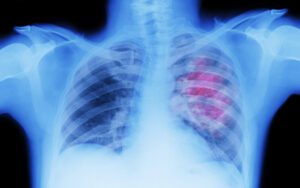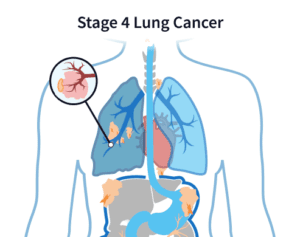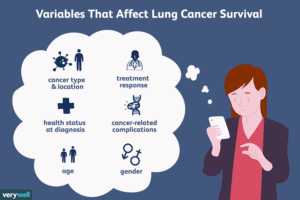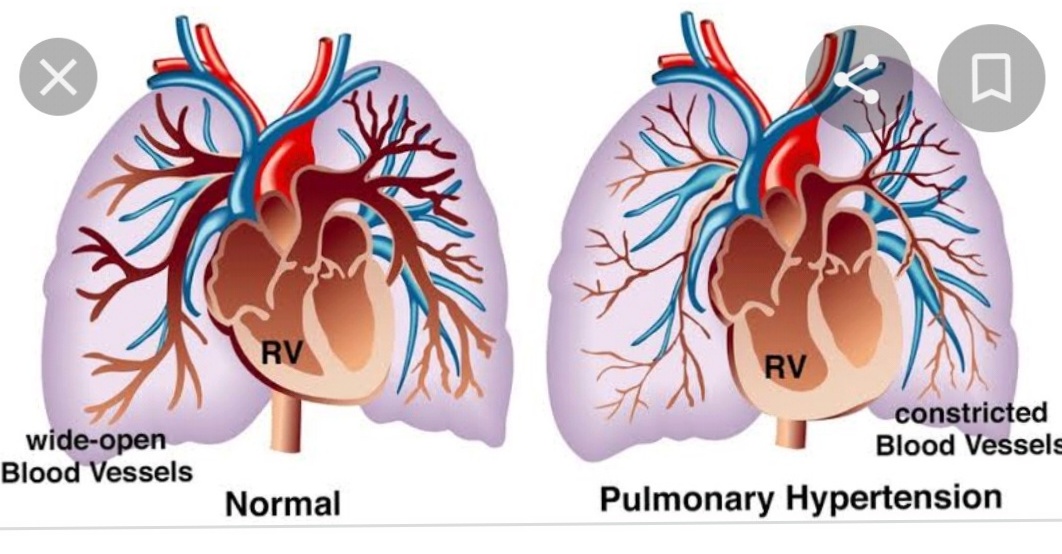“How Long Will I Live With Lung Cancer? Real Survival Facts & Hopeful Advances”
The length of time a person lives with lung cancer depends on a number of variables, such as the stage of the disease at diagnosis, the specific kind of lung cancer, and the patient’s general health and reaction to therapy. The proportion of individuals who are still alive five years after their diagnosis is often represented by the five-year survival rate for lung cancer.


Rates of Overall Survival by Stage:
I: The Stage
The prognosis for early-stage lung cancer (Stage I) is the best, with 5-year survival rates between 70% and 90%.
Phase II:
With 5-year survival rates between 50% and 60%, Stage II lung cancer has reduced survival rates.
III. Stage:
The survival outcomes for stage III lung cancer vary greatly. Some patients may experience 5-year survival rates as high as 30% to 40%, while others may see them as low as 20%.
Stage IV:
With a 5-year survival rate of about 5%, Stage IV lung cancer, in which the malignancy has spread to far-flung areas of the body, is linked to a significantly worse prognosis.
Additional Considerations Affecting Survival:
Type of Cancer:
In comparison to non-small cell lung cancer (NSCLC), small cell lung cancer (SCLC) has a distinct prognosis and is typically discovered later in the course of the illness.
Treatment:
Procedures such as surgery, radiation therapy, chemotherapy, and targeted therapies have a big influence on both survival and quality of life.
Health of the Individual:
The length of time a person lives with lung cancer can also be affected by factors such age, general health, and lifestyle decisions such as smoking.
Key Considerations:
The group of individuals used to calculate survival rates is just an estimate. They don’t forecast how long anyone will live.
Improvements in Therapy: Lung cancer patients are seeing better outcomes all the time.
Early detection is essential for increasing survival rates.
Quality of life is crucial, particularly for those with advanced lung cancer, so pay attention to it.
To have a better understanding of your prognosis and treatment choices, it is imperative that you speak with your doctor about your unique circumstances.
Lung cancer survival
There are several variables that affect survival. No one can tell you for sure how long you’ll live.
The following are general figures based on huge populations. Keep in mind that they are unable to predict the outcome of your particular situation.


Concerning these figures
The words 1-year survival and 5-year survival do not imply that you will only live for one or five years.
Researchers, other health organizations, and the NHS gather data. They document what occurs to cancer patients in the years following their diagnosis. 5 years is a typical interval for assessing survival. However, certain people live much longer than that.
The number of individuals who have not died from their cancer within five years of diagnosis is their five-year survival rate.
By stage, survival
There are no national UK data on lung cancer survival by stage.
In England, there are survival statistics for every stage of lung cancer. These statistics apply to those who were diagnosed in England between 2016 and 2020. The age of lung cancer patients is not taken into account by these statistics, which are not age-standardized.
What determines survival
The size of the cancer and whether it has metastasized will determine your prognosis.
Your chances of survival may depend on the kind of cancer. The kind refers to the sort of cell from which the cancer originated.
Survival is also influenced by your overall fitness and health. You might be better able to manage your cancer and treatment if you’re in good physical condition.
Gene modifications (mutations) can also have an impact on lung cancer survival. You will undergo the FISH test, which looks for gene changes.
How Long Do You Survive With Stage 4 Lung Cancer?


Therefore, if you or a loved one has received this diagnosis, it is essential to understand that the battle ahead will be exceedingly tough. Nevertheless, it is crucial to persist in the fight and maintain hope. Below is vital information regarding stage 4 lung cancer and its survival rates.
How Lethal Is Stage 4 Lung Cancer and Is Treatment Possible?


The prognosis for each individual case is influenced by various factors, including the specific type of lung cancer, the patient’s age and overall health, and the cancer’s responsiveness to treatment. Generally speaking, stage 4 lung cancer is regarded as the most advanced and challenging form of the disease to treat.
Although multiple treatment options exist, the success rates for stage 4 lung cancer are regrettably quite low. However, it is important to note that there are exceptions, and some patients diagnosed with stage 4 lung cancer have managed to lead long and healthy lives.
What Is the Average Life Expectancy for Individuals with Stage 4 Lung Cancer?
The typical life expectancy for a person diagnosed with stage 4 lung cancer is approximately one year. Nonetheless, some individuals may survive for a longer duration, while others may have a shorter lifespan. The treatment options for lung cancer and the overall health of the individual can significantly influence the longevity of someone with stage 4 lung cancer.
Causes of Lung Cancer
Lung cancer arises from various factors, including smoking, exposure to secondhand smoke, and contact with carcinogens such as asbestos and radon.
Smoking is the primary cause of lung cancer, responsible for about 85% of all instances. Cigarette smoke comprises over 70 recognized carcinogens, such as tar, nicotine, and carbon monoxide. These chemicals harm lung cells and elevate the likelihood of cancer.
Secondhand smoke is another contributor to lung cancer. When individuals inhale secondhand smoke, they encounter the same carcinogens as smokers, thereby heightening their risk of developing lung cancer.
Exposure to carcinogens like asbestos and radon further raises the risk of lung cancer. Asbestos, a mineral frequently utilized in construction and various industries, can lead to lung cancer when inhaled. Radon can infiltrate homes and accumulate to hazardous levels. Prolonged exposure to elevated radon levels can also result in lung cancer.
Symptoms of Lung Cancer
The symptoms of lung cancer can be challenging to detect in the early phases of the illness. They may manifest as a persistent cough, blood in sputum, shortness of breath, and chest discomfort. As the condition advances, symptoms may intensify and include weight loss, fatigue, and difficulty swallowing.
Treatment for Stage 4 Lung Cancer
At this stage, the cancer has metastasized to other areas of the body, such as the bones or liver. Treatment alternatives are limited, and the prognosis is unfavorable. Surgery is not feasible, and radiation therapy may only provide symptomatic relief. Chemotherapy serves as the primary treatment method, and palliative care may also be suggested to assist in symptom management and enhance quality of life.



